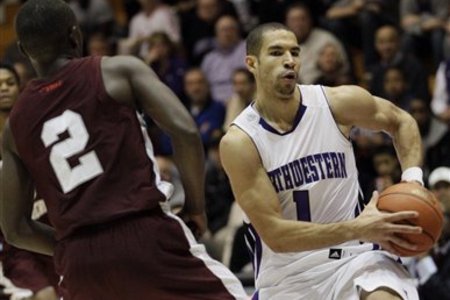Northwestern’s Lack of Rebounding Becoming a Huge Factor
Posted by rtmsf on March 1st, 2012Bill Hupp is an RTC correspondent. You can follow him on Twitter (@Bill_Hupp). He filed this report following Northwestern’s last-second loss to Ohio State on Wednesday night.
Purple Pain
It was hard to tell if the cheers erupting from Northwestern students after consecutive rebounds by the Wildcats on Wednesday night were sarcastic or an ironic roar acknowledging the event’s rarity. As has been the case in most games this season, Northwestern was dominated on the backboards in their 75-73 last-second loss to Ohio State. At the half, the Buckeyes were outrebounding the ‘Cats 22-5, as interior beasts DeShaun Thomas and Jared Sullinger had 25 of the Buckeyes’ 39 points (and OSU had poured in 20 points in the paint). “They killed us on a second-chance shots in the first half,” Northwestern coach Bill Carmody admitted. “They destroyed us on the backboards.” With Northwestern employing their trademark 1-3-1 zone, OSU used their superior size and athleticism to outrebound the Wildcats 44-18, grab 20 offensive boards (11 by Sullinger) and score 20 second chance points.
Still, Ohio State Coach Thad Matta dismissed the gaudy rebounding differential as largely irrelevant. “That’s misleading because a lot of teams do that and don’t beat them,” Matta said. “[But] we felt we could do a heck of a job rebounding if they played their 1-3-1 zone.” If the NCAA Tournament bubble upon which Northwestern firmly sits does burst, the Wildcats will look back and point to poor post play this season as a major reason. It’s not a question of work ethic as Davide Curletti, Luka Mirkovic, John Shurna, and Drew Crawford all battle and scrap down low. But the foursome are finer, more finesse players, athletes not equipped to sustain success against the rigors of conference post play.
Fatigue often plays a factor as Northwestern’s bench only goes seven deep and features three of the Big Ten’s top nine in minutes played. There’s also no doubt that rebounding is more difficult out of the 1-3-1 zone. With Shurna manning the right wing, small guards like David Sobolewski and Reggie Hearn end up battling down on the blocks when a shot goes up. The Big Ten is a difficult conference to win in consistently regardless, but especially if you don’t rebound or play much defense. The Wildcats rank last in the conference in every statistical rebounding category (offensive, defensive and rebounding margin). Ohio State, conversely, ranks second in every category behind only perennial window cleaners Michigan State. Part of Northwestern’s weakness can be attributed to their motion offense, which is complicated and perimeter-based.
Bill Carmody’s Princeton offense is designed to either get either a layup or a three-pointer. Guys occasionally post up, but no one in purple really crashes the offensive glass. No, they would rather sprint back, set up in their zone, and prevent you from getting easy fast-break points. You may score at will on offense against the Wildcats, but it will be in the half-court, dammit! Ultimately, however, it’s been an unfortunate combination of injury problems and an inability to win close games that has left Northwestern in this position, perched precariously on the tournament bubble. There were agonizing home losses to Ohio State, Purdue, Illinois and Michigan, and narrow road failures at Creighton, Michigan and Purdue. But the Wildcats are 2-10 against the RPI Top 50 after Wednesday night. The NCAA Tournament Committee hasn’t traditionally shown much of a propensity toward sentimentality, and even Northwestern’s players know that, in the end, close just doesn’t cut it. “Every loss is tough,” Crawford said, “especially when you’re at home and you have a chance to win it at the end.”











































